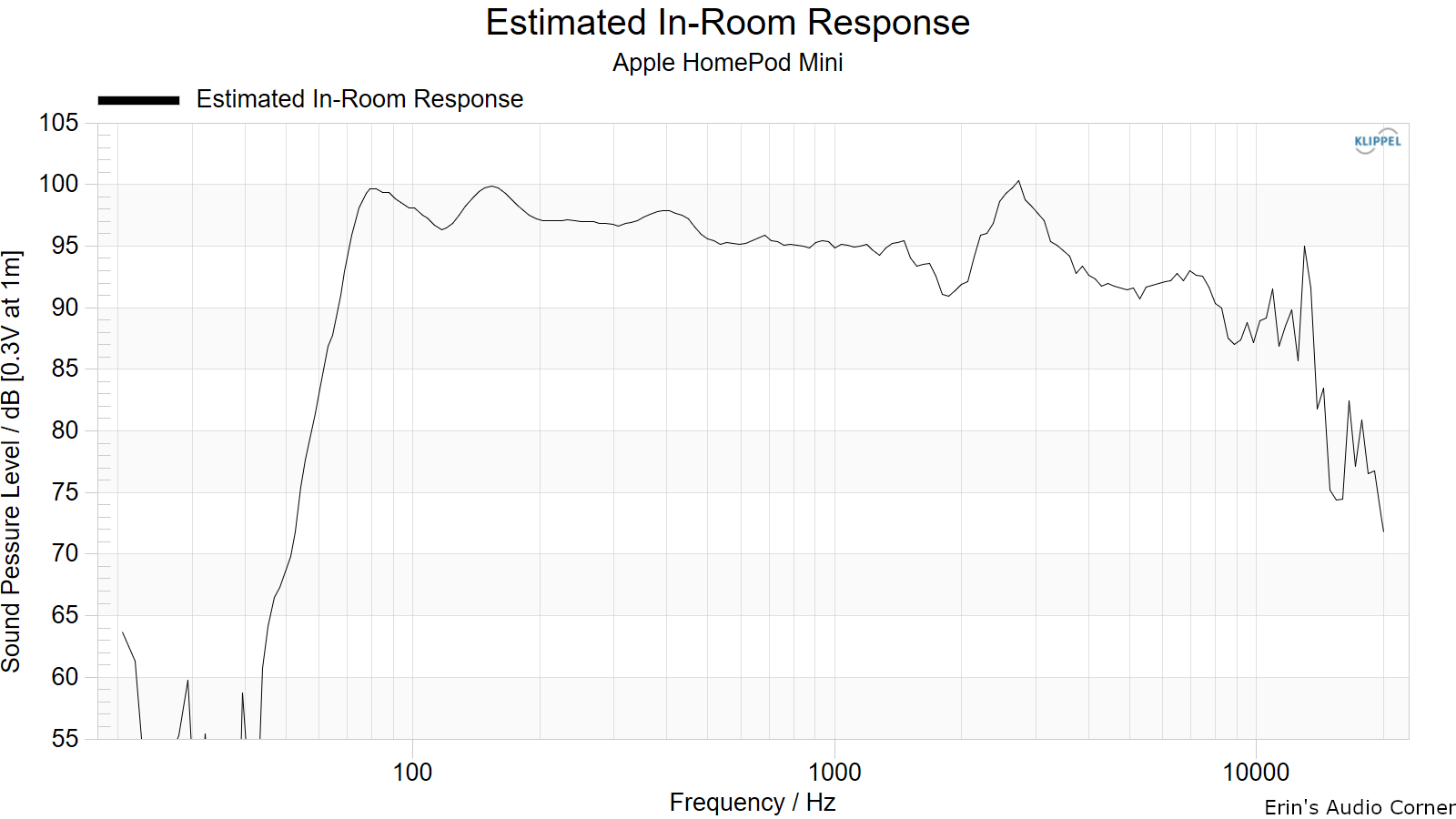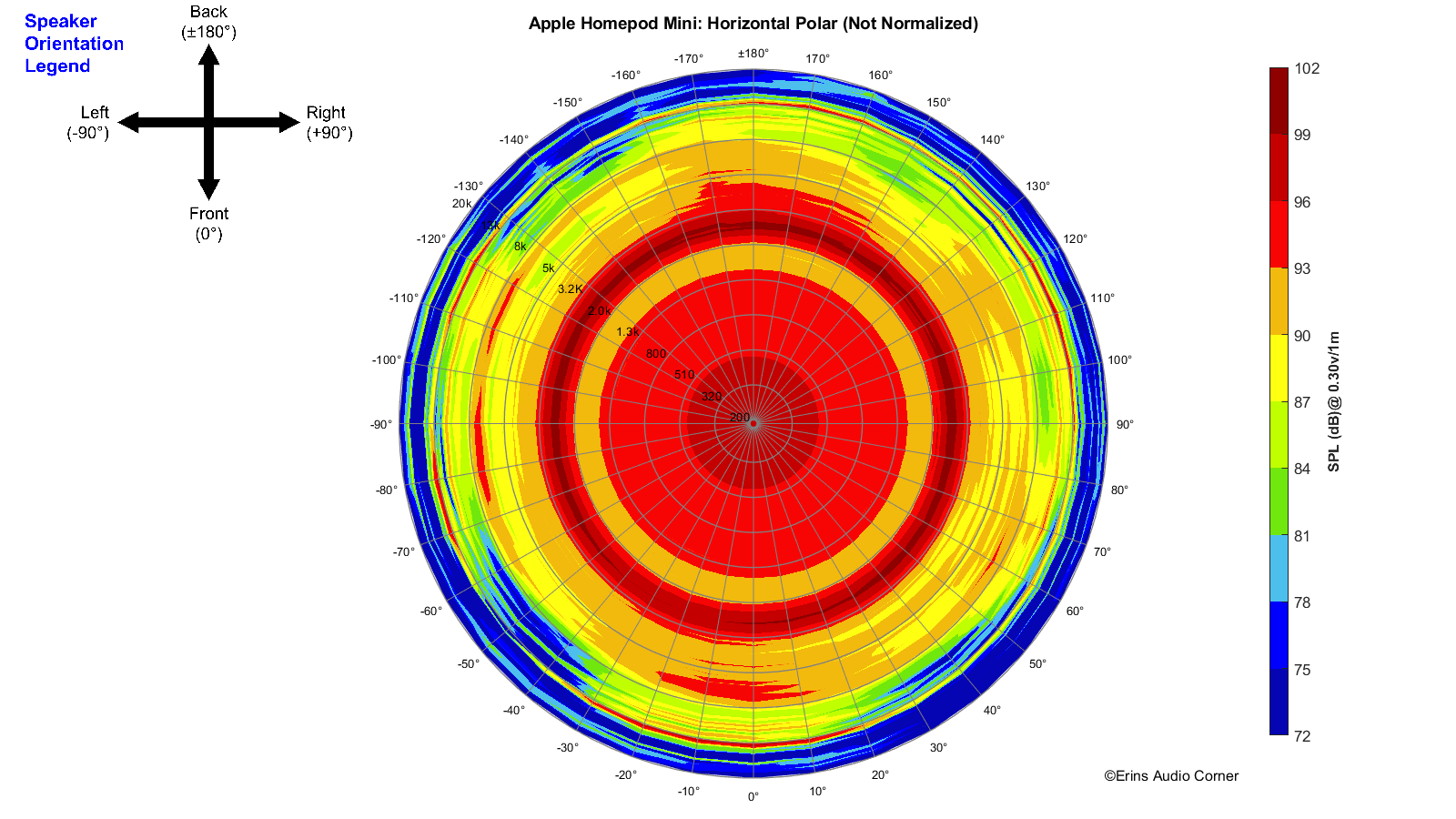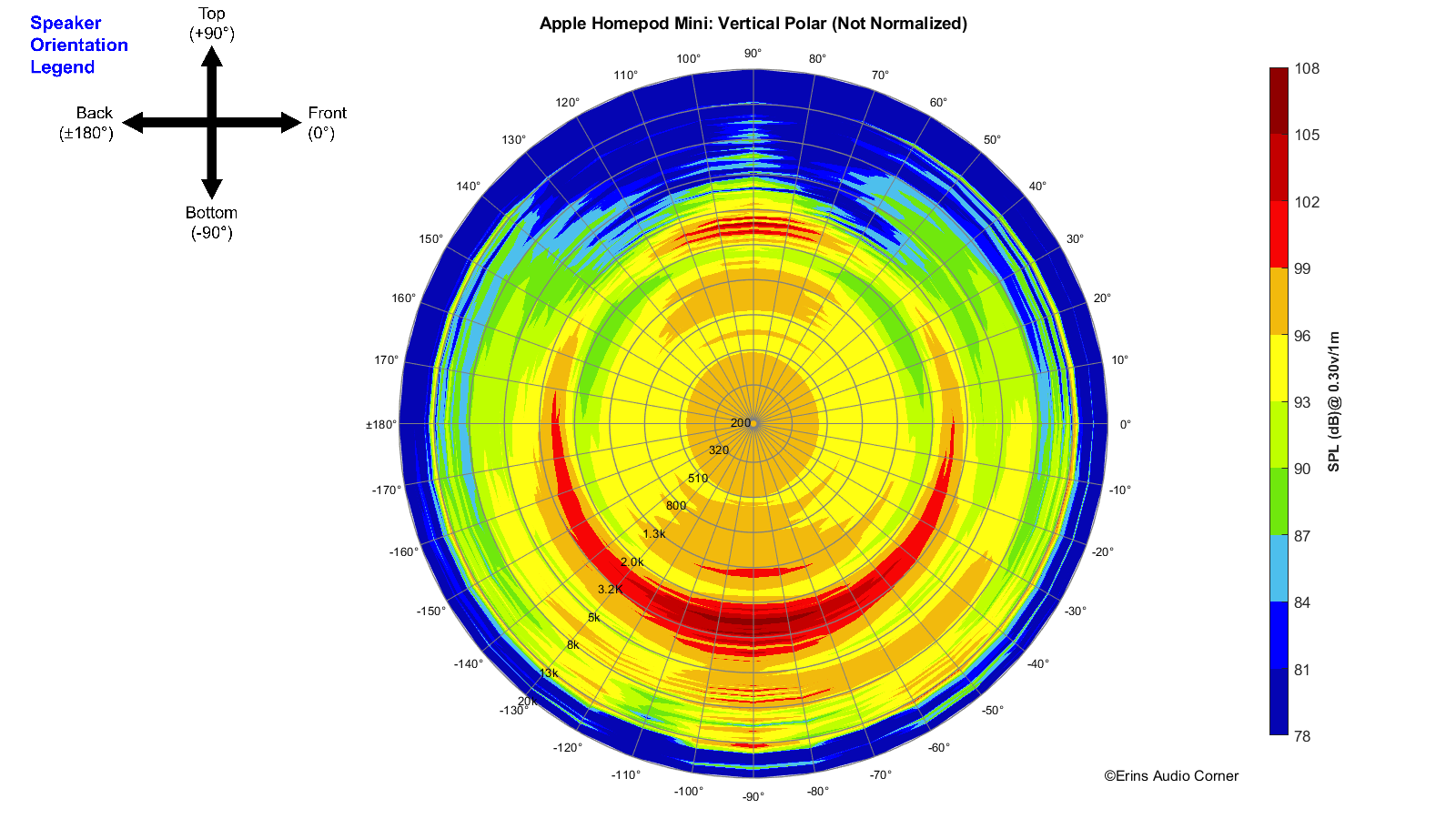Copy/paste from my site. Review may not translate from my site so here is the link to the full review on my site:
https://www.erinsaudiocorner.com/loudspeakers/apple_homepod_mini/
Apple HomePod Mini

Foreword / YouTube Video Review
The review on this website is a brief overview and summary of the objective performance of this speaker. It is not intended to be a deep dive. Moreso, this is information for those who prefer “just the facts” and prefer to have the data without the filler.
Note: Coming Soon
For a primer on what the data means, please watch my series of videos where I provide in-depth discussion and examples of how to read the graphics presented hereon.
https://youtube.com/playlist?list=PLnIxFR_ey0b37Ex4KV2mBz-kYB7QLffR1
Information and Photos
The Apple HomePod Mini is smart speaker intended to be paired with your Apple ecosystem, providing you with access to music, news and Siri. Currently, these are sold in singles for $99 USD and two can be configured to work as a stereo pair. The design of this speaker is different in that it is intended to provide 360° sound throughout the room and does so using a “fullrange” drive-unit with a waveguide paired with a bass driver and passive radiators to provide the lower frequency content. See below photo for illustration.


CTA-2034 (SPINORAMA) and Accompanying Data
All data collected using Klippel’s Near-Field Scanner. The Near-Field-Scanner 3D (NFS) offers a fully automated acoustic measurement of direct sound radiated from the source under test. The radiated sound is determined in any desired distance and angle in the 3D space outside the scanning surface. Directivity, sound power, SPL response and many more key figures are obtained for any kind of loudspeaker and audio system in near field applications (e.g. studio monitors, mobile devices) as well as far field applications (e.g. professional audio systems). Utilizing a minimum of measurement points, a comprehensive data set is generated containing the loudspeaker’s high resolution, free field sound radiation in the near and far field. For a detailed explanation of how the NFS works and the science behind it, please watch the below discussion with designer Christian Bellmann:
This was a tricky one to test. Realistically, this speaker is almost guaranteed to be placed on a surface, a countertop, the ground, etc. In doing so, the high frequency content that is downward-firing is then reflected back into the room which is obviously atypical of a conventional speaker. There is no easy way to test this without performing an outdoor set of measurements and even doing that yields its own set of challenges relative to “use case” for this speaker. So, I have measured this speaker anechoically - the same as I do for all my other measurements - using the Klippel NFS. The rationale for this is simple: given that this is a device that is less about “ideal listening conditions” and more about “convenience”, I am less interested in the absolute accuracy of the frequency response and more interested in the radiation pattern and the maximum SPL limits. In other words, most will be listening to this while moving about the home or as background music but I can’t imagine many attempting to use a HomePod Mini for “critical listening”. The goal of this review is to answer some basic questions: can you hear this speaker while walking around the kitchen and in other rooms as you walk about the horse completing chores?
Additionally, this speaker has no auxiliary input and thus was tested via Bluetooth using Klippel’s Application Note 72.
With the above said, the reference plane in this test is at the waveguide level. Just above the bottom of the speaker. Volume set to max. Unlike its bigger brother - the HomePod - there is no adaptive EQ in the HomePod Mini. So there was nothing to disable in terms of “DSP” other than “soundcheck” (which is only used to normalize music as track to track variation can be louder or quieter).
I modified the NFS to use a pole, placing the speaker on top rather than directly on top of the NFS’ platform. This was done to make sure there was no artifacts - comb filtering - from the stand back to the microphone as this is intended to provide anechoic data, as previously discussed. This can be seen below.

Measurements are provided in a format in accordance with the Standard Method of Measurement for In-Home Loudspeakers (ANSI/CTA-2034-A R-2020). For more information, please see this link.
CTA-2034 / SPINORAMA:

Early Reflections Breakout:

Estimated In-Room Response:

Horizontal Frequency Response (0° to ±90°):

Vertical Frequency Response (0° to ±40°):

Horizontal Contour Plot (not normalized):

Vertical Contour Plot (not normalized):

Additional Measurements
“Globe” Plots
These plots are generated from exporting the Klippel data to text files. I then process that data with my own MATLAB script to provide what you see. These are not part of any software packages and are unique to my tests.
Horizontal Polar (Globe) Plot:
This represents the sound field at 2 meters - above 200Hz - per the legend in the upper left.

Vertical Polar (Globe) Plot:
This represents the sound field at 2 meters - above 200Hz - per the legend in the upper left.

Harmonic Distortion
Harmonic Distortion at max volume (83dB @ 1m). This was literally the loudest I could set the HomePod Mini to play via Bluetooth:

Parting Thoughts
Support / Contribute
If you like what you see here and want to help me keep it going, please consider donating via the PayPal Contribute button below. https://www.erinsaudiocorner.com/contribute/
https://www.erinsaudiocorner.com/loudspeakers/apple_homepod_mini/
Apple HomePod Mini
- Sunday, Jun 27, 2021

Foreword / YouTube Video Review
The review on this website is a brief overview and summary of the objective performance of this speaker. It is not intended to be a deep dive. Moreso, this is information for those who prefer “just the facts” and prefer to have the data without the filler.
Note: Coming Soon
For a primer on what the data means, please watch my series of videos where I provide in-depth discussion and examples of how to read the graphics presented hereon.
https://youtube.com/playlist?list=PLnIxFR_ey0b37Ex4KV2mBz-kYB7QLffR1
Information and Photos
The Apple HomePod Mini is smart speaker intended to be paired with your Apple ecosystem, providing you with access to music, news and Siri. Currently, these are sold in singles for $99 USD and two can be configured to work as a stereo pair. The design of this speaker is different in that it is intended to provide 360° sound throughout the room and does so using a “fullrange” drive-unit with a waveguide paired with a bass driver and passive radiators to provide the lower frequency content. See below photo for illustration.


CTA-2034 (SPINORAMA) and Accompanying Data
All data collected using Klippel’s Near-Field Scanner. The Near-Field-Scanner 3D (NFS) offers a fully automated acoustic measurement of direct sound radiated from the source under test. The radiated sound is determined in any desired distance and angle in the 3D space outside the scanning surface. Directivity, sound power, SPL response and many more key figures are obtained for any kind of loudspeaker and audio system in near field applications (e.g. studio monitors, mobile devices) as well as far field applications (e.g. professional audio systems). Utilizing a minimum of measurement points, a comprehensive data set is generated containing the loudspeaker’s high resolution, free field sound radiation in the near and far field. For a detailed explanation of how the NFS works and the science behind it, please watch the below discussion with designer Christian Bellmann:
This was a tricky one to test. Realistically, this speaker is almost guaranteed to be placed on a surface, a countertop, the ground, etc. In doing so, the high frequency content that is downward-firing is then reflected back into the room which is obviously atypical of a conventional speaker. There is no easy way to test this without performing an outdoor set of measurements and even doing that yields its own set of challenges relative to “use case” for this speaker. So, I have measured this speaker anechoically - the same as I do for all my other measurements - using the Klippel NFS. The rationale for this is simple: given that this is a device that is less about “ideal listening conditions” and more about “convenience”, I am less interested in the absolute accuracy of the frequency response and more interested in the radiation pattern and the maximum SPL limits. In other words, most will be listening to this while moving about the home or as background music but I can’t imagine many attempting to use a HomePod Mini for “critical listening”. The goal of this review is to answer some basic questions: can you hear this speaker while walking around the kitchen and in other rooms as you walk about the horse completing chores?
Additionally, this speaker has no auxiliary input and thus was tested via Bluetooth using Klippel’s Application Note 72.
With the above said, the reference plane in this test is at the waveguide level. Just above the bottom of the speaker. Volume set to max. Unlike its bigger brother - the HomePod - there is no adaptive EQ in the HomePod Mini. So there was nothing to disable in terms of “DSP” other than “soundcheck” (which is only used to normalize music as track to track variation can be louder or quieter).
I modified the NFS to use a pole, placing the speaker on top rather than directly on top of the NFS’ platform. This was done to make sure there was no artifacts - comb filtering - from the stand back to the microphone as this is intended to provide anechoic data, as previously discussed. This can be seen below.
Measurements are provided in a format in accordance with the Standard Method of Measurement for In-Home Loudspeakers (ANSI/CTA-2034-A R-2020). For more information, please see this link.
CTA-2034 / SPINORAMA:

Early Reflections Breakout:
Estimated In-Room Response:

Horizontal Frequency Response (0° to ±90°):

Vertical Frequency Response (0° to ±40°):

Horizontal Contour Plot (not normalized):

Vertical Contour Plot (not normalized):

Additional Measurements
“Globe” Plots
These plots are generated from exporting the Klippel data to text files. I then process that data with my own MATLAB script to provide what you see. These are not part of any software packages and are unique to my tests.
Horizontal Polar (Globe) Plot:
This represents the sound field at 2 meters - above 200Hz - per the legend in the upper left.

Vertical Polar (Globe) Plot:
This represents the sound field at 2 meters - above 200Hz - per the legend in the upper left.

Harmonic Distortion
Harmonic Distortion at max volume (83dB @ 1m). This was literally the loudest I could set the HomePod Mini to play via Bluetooth:
Parting Thoughts
- The speaker response is practically omnidirectional. I believe the reason you see a divergence in the higher frequencies is due to comb filtering from the power cord that is hardwired in to the unit (the only pluggable end is at the wall-outlet adapter).
- As I discussed earlier, the high frequency response is likely to be misleading because the speaker is designed to be listened to while sitting on a surface. That will (should) increase the HF output but it, too, will still suffer effects of comb filtering based on the angle of the waveguide with respect to the opening of the mouth. But honestly, as this speaker is likely to be used, I don’t think many will even care. Again, this is not a “critical listening” speaker. It is a convenience speaker. The purpose is different and should be weighed with the analysis of the data. In other words, don’t draw the wrong conclusion; consider how this will be used.
- The loudest I could get this unit to go was approximately 83dB at 1 meter (anechoic).
- If you are wondering where the compression testing is, well, that’s because I had no viable way to test this. With Bluetooth, I don’t know how much voltage the speaker is receiving to calculate a theoretical gain in dBSPL. Therefore, I can’t calculate what the compression is based on what the SPL should be since I don’t know what the SPL should be.
Support / Contribute
If you like what you see here and want to help me keep it going, please consider donating via the PayPal Contribute button below. https://www.erinsaudiocorner.com/contribute/
Last edited:

